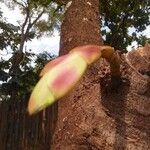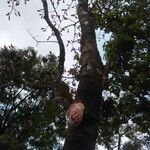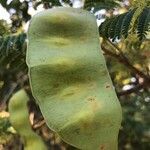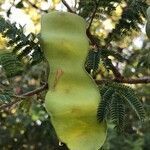Tree 1.5–15 m. high, deciduous; crown flat or compressed-rounded; bark fissured, reticulate.. Young branchlets with grey to pale brown (when dry) spreading pubescence, not silvery.. Leaves: gland on upper side of petiole (often absent) prominent and sometimes shortly stalked, (0.25–)0.5–1 mm. high; pinnae 6–20(–22) pairs; leaflets (7–)12–27(–30) pairs, 2–6(–7) mm. long, (0.6–)1–1.25(–2) mm. wide, ± falcate, apex asymmetrical, acute, the point turned towards apex of pinna, ± appressed-pubescent on both sides, or glabrous or nearly so above even when young; midrib nearer upper margin; lateral nerves ± raised and visible beneath; lower surface of leaflet paler.. Flowers white, sessile or up to 0.5 mm. pedicellate; bracteoles persistent during flowering time.. Calyx 1.5–2.5 mm. long, densely pubescent outside.. Corolla 3.5–6 mm. long, densely pubescent outside.. Staminal tube not or scarcely exserted beyond corolla; filaments about 1.5–2 cm. long.. Pod oblong, 8–18(–25 fide F.C.B.) cm. long, (1.5–)2.5–3.5 cm. wide, glabrous or nearly so except for a little pubescence near base and along margins, brown to purple.. Seeds 8–12 mm. long, 6–9 mm. wide, flattened.. Fig. 20, p. 150.
A tree. It grows 15 m tall. It loses its leaves during the year. The crown is rounded and the stems are bare. The bark is dark grey-brown and has ridges along it. The leaves are compound and twice divided. They have a feathery appearance. There are 12-24 pairs of leaflets along 15 pairs of side stalks (pinnae). The leaflets are slightly curved. They have a sharp point. They are pale green underneath. The flower heads are round. They are creamy-white. They are at the ends of twigs and about 3 cm across. The fruit are flat pods. They are large and rusty-red and hang down. The pods are 15 cm long by 3.5 cm wide. They split open easily.
Leaves: gland on upper side of petiole prominent and sometimes shortly stalked, or often absent, (0·25)0·5-1 mm. high; pinnae 6-20(26) pairs; leaflets (7)12-27(30) pairs, 2-6(7) x (0·6)1-1·25(2) mm., ± falcate, apex asymmetric, acute, the point turned towards the apex of the pinna, ± appressed-pubescent on both surfaces, or glabrous or nearly so above even when young; midrib nearer the distal margin; lateral nerves ± raised and visible beneath; lower surface of leaflet paler.
Tree 1·5-15(20) m. high, deciduous; crown flat or compressed-rounded; bark grey-brown to blackish, rough, fissured, reticulate; young branchlets with grey to pale-brown (when dry) spreading pubescence, not silvery.
Tree. Mature leaves clothed with grey to golden, spreading indumentum; leaflets 0.5-1.5 mm wide, apex acute, asymmetrical, falcate, point turned towards apex of pinna. Pods usually glabrous. Flowers creamy white.
Pod dehiscent, brown to purple, 8-18(25 fide F.C.B.) x (1·5)2·5-3·5 cm., oblong, glabrous or nearly so except for a little pubescence near the base and along the margins.
Flowers white, sessile or up to 0·5 mm. pedicellate; bracteoles persistent during flowering time.
Staminal tube not or scarcely exserted beyond the corolla; filaments c. 1·5-2 cm. long.
Corolla 3·5-6 mm. long, densely pubescent outside.
Calyx 1·5-2·5 mm. long, densely pubescent outside.
Seeds 8-12 x 6-9 mm., flattened.





